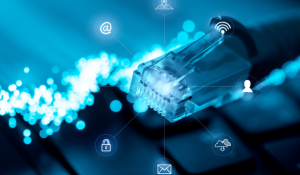12 onion websites: A look at the dark web
In the depths of the internet, there is an area that is not accessible via conventional search engines: the dark web. This part of the internet is...

The darknet, also known as the dark web, is a hidden part of the internet that cannot be accessed via normal search engines such as Google or Bing. It is notorious as a hub for illegal activities such as drug dealing, arms sales and even human trafficking. But it's not all bad.
| TABLE OF CONTENT |
The dark web also offers a degree of privacy and anonymity that can be used for legitimate purposes, such as protecting dissidents and journalists from persecution. In this blog post, we will explore the good, the bad and the downright ugly sides of the dark web.
The darkweb is a part of the internet that is not publicly accessible and therefore cannot be found using conventional search engines. It is part of the deep web, which in turn includes all websites and content that are not indexed by search engines.
The darknet is known for its anonymity and lack of centralised control. It is accessed via encrypted networks such as Tor (The Onion Router), which routes data traffic via various nodes to conceal the identity of users.
Various types of content can be found on the Darknet, including illegal activities such as the trade in drugs, weapons, stolen data and other illegal goods. There are also forums and marketplaces for cybercrime, hacking services, forged documents and much more.
In summary, the dark web functions as a hidden, decentralised network within the internet. Access requires special tools, Tor being the most common, and is characterised by strong anonymity, encryption and the absence of conventional search engine indexing. It serves as both a platform for privacy protection and a haven for criminal activity, making its exploration a significant security concern.
While the overall dark web environment can be complex, understanding the specific role of dark web search engines is key for IT security specialists navigating this hidden part of the internet. Unlike their clear web counterparts, these specialized search tools are purpose-built to index and categorize content within encrypted networks like Tor. They function as critical access points, offering unique capabilities and challenges for both benign and malicious actors.
Dark web search engines primarily serve the following functions:
Content Discovery and Indexing: Their fundamental role is to overcome the inherent anonymity and isolation of onion websites. Specialized crawlers, operating within the Tor network, actively seek out and index ".onion" domains that are intentionally hidden from traditional search engines. This laborious process allows them to build databases of hidden services, which can range from legitimate private forums to illicit marketplaces.
Facilitating Threat Intelligence and Research: For IT security professionals in sectors like healthcare, manufacturing, or critical infrastructure, dark web search engines are invaluable for proactive threat intelligence. They enable the discovery of leaked credentials, intellectual property, or discussions related to zero-day exploits and ransomware. This visibility is crucial for understanding emerging threats and bolstering an organization's defensive posture.
Providing a (Limited) Organizational Structure: Despite the decentralized nature of the dark web, some dark web search engines attempt to impose a degree of order. They may offer categorization, filtering capabilities (though often limited), or even try to exclude known malicious sites. This can help users, including security researchers, to more efficiently locate specific types of information, reducing the time and risk associated with indiscriminate Browse.
The open web refers to the publicly accessible part of the Internet that is indexed and searchable by search engines. It includes websites, resources and information that any user can access without restrictions. The open web is the part of the internet that most people use every day to search for information, visit websites and use online services.
The deep web, on the other hand, refers to the part of the internet that is not publicly accessible and is not indexed by search engines. This includes databases, protected websites, password-protected areas and other content that is not publicly accessible. Access to the deep web requires special authorisations, authentication or the use of special software such as the Tor network.
Darknet, open web and deep web are three different concepts that describe different areas of the internet. Here are the differences between them:
The darknet is the part of the internet that is deliberately hidden and anonymised. It is accessed via overlay networks such as Tor and offers anonymity and encryption.
The darknet is often used for illegal activities such as trading illegal goods, drugs, stolen data and even illegal services.
Access to the darknet requires special software, such as the Tor browser, to ensure the anonymity of users.
The Open Web is the publicly accessible part of the Internet that is indexed by search engines and can be accessed by any user without special restrictions.
Most of the websites and information we find on the Internet belong to the Open Web.
Search engines such as Google enable us to search for and access information on the open web.
The deep web refers to the part of the internet that is not publicly accessible and is not indexed by search engines. It contains protected areas, databases, password-protected websites and other content that is not accessible to the general public.
For example, the deep web may contain private email accounts, bank accounts, online shops with restricted access or government resources.
Access to the deep web usually requires specific authorisations or authentication in order to access the content.
Here is a graphic which illustrates how does the structure of the web looks like:

Special technical procedures and tools are required to gain access to the dark web, especially to navigate the anonymised and encrypted infrastructure. Unlike the surface web, which can be accessed using standard browsers, the dark web requires the use of specialised software, most notably the Tor browser, as well as an understanding of its unique addressing system. Here is a breakdown of the steps required:
Using the Tor Browser: The most common method for accessing the dark web is the Tor Browser, a modified version of Firefox. This browser is available for free on the official Tor Project website and is essential because it implements onion routing, a technique that encrypts Internet traffic and routes it through multiple relay servers or ‘nodes’ to disguise the user's IP address and location. This layered encryption and routing is critical to maintaining user anonymity.
Connecting to the Tor network: When the Tor Browser is launched, it automatically connects to the Tor network, which requires establishing a connection through multiple nodes. This initial connection process can be slower than a normal Internet connection due to the multi-layered encryption and the need to route traffic through numerous relays. This process serves to anonymise the origin and destination of the user, but also has an impact on performance.
Understanding ‘.onion’ domains: In contrast to conventional URLs, dark web addresses use the top-level domain (TLD) ‘.onion’. These addresses are not resolved by normal DNS (Domain Name System) servers. ‘.onion’ addresses are often long, seemingly random strings that are generated by the Tor network and are only accessible via the Tor browser. This feature is a key difference between the dark web and conventional websites.
Navigating the dark web: To access certain content on the dark web, you need to know the exact ‘.onion’ URL. These URLs are not indexed by regular search engines, so Dark Web-specific search engines such as DuckDuckGo or specialised forums and link directories often have to be used to discover them. It is important to check the source of these URLs as some of them may lead to malicious or illegal websites.
Implementation of security measures: Before accessing the dark web, it is recommended to take various security measures, including:
Use a virtual private network (VPN): a VPN can be used in conjunction with the Tor browser to further increase anonymity.
Use strong antivirus and malware protection: As the dark web is a common place for malware to spread, installing and activating a solid antivirus programme before exploring the web is crucial.
Disabling JavaScript: Since many dark web sites use JavaScript to track users or spread malware, it is a good practice to disable JavaScript in the Tor browser settings. However, it should be noted that this may affect the functionality of some websites.
It is important to note that accessing the darknet can expose you not only to illegal activity, but also to potential security risks. The darknet is known for illegal activities and visiting such websites can have legal consequences. It is therefore advisable to exercise extreme caution and strictly adhere to the laws and guidelines of your own country.
Each of the following websites offers different services, from marketplaces to secure communication, illustrating the diverse uses of the dark web and the continuing demand for online anonymity and security.
The Hidden Wiki - This site acts as a directory for various dark web sites and provides a number of links to forums, markets and other hidden services. It is a much-visited resource for beginners looking for information on navigating the dark web.
Dread - Often compared to Reddit, Dread is a dark web forum where users discuss a wide range of topics, from cryptocurrencies to privacy issues. It is particularly popular with users looking for updates on dark web activity and markets.
SecureDrop - This whistleblowing platform allows journalists and individuals to share sensitive information anonymously. Many media organisations use SecureDrop to receive tips without compromising the privacy of their sources.
AlphaBay - Another notable marketplace best known for its variety of goods and focus on privacy. After its closure, new marketplaces have tried to copy its model.
Hidden Answers - A Q&A forum similar to Quora where users can ask and answer questions anonymously. It's a resource for discussions on everything from navigating the dark web to tech support, and often covers topics that wouldn't be openly discussed on the regular web.
For journalists, whistleblowers and activists working in repressive environments, the dark web can be a vital tool for sharing information securely and circumventing censorship. It is therefore essential to understand the tools and services that enable its navigation in order to recognise both its potential benefits and inherent risks.
Tor Browser: A modified Firefox browser that encrypts internet traffic and routes it through multiple nodes to obfuscate the user's IP address and location.
.onion addresses: Dark web addresses that are not resolved by normal DNS servers and are only accessible via the Tor browser.
VPN (Virtual Private Network): Can be used in conjunction with the Tor Browser to further increase anonymity.
Virus and malware protection: A solid antivirus programme is essential to protect against malware that is spread on the dark web.
JavaScript disabling: Disabling JavaScript in the Tor browser settings can reduce the risk of tracking and malware infections.
SecureDrop: Whistleblowing platform that allows journalists and individuals to share sensitive information anonymously.
The tools and services presented here are critical to navigating this complex landscape, but they require responsible use. Ultimately, it is up to us to recognise the power of the dark web and ensure that it is used for the common good and not for malicious purposes.
Beyond dedicated search engines, dark web forums represent a significant, dynamic, and often illicit, component of the dark web. These anonymous discussion boards, much like their surface web counterparts, serve as communities where individuals can exchange information, goods, and services. However, due to the inherent anonymity of the dark web, these forums often become breeding grounds for cybercriminal activities, making their understanding and monitoring a critical aspect of modern IT security.
Dark web forums play several key roles and are explored for various reasons:
Information Exchange and Collaboration: Forums are primary hubs where threat actors share knowledge, including hacking techniques, exploit methods, and details of newly discovered vulnerabilities. Monitoring these discussions can provide insights into attack methodologies and emerging malware.
Marketplaces for Illicit Goods and Services: A significant portion of dark web forums operate as marketplaces for illegal commodities. This includes the trading of stolen data (e.g., credit card details, login credentials, patient records), sale of malware and ransomware-as-a-service (RaaS), and even recruitment for cybercriminal operations. Understanding these marketplaces is crucial for identifying if your organization's sensitive data has been compromised and is being offered for sale.
Recruitment and Communication Channels: Cybercriminal groups frequently use dark web forums to recruit new members, coordinate attacks, and communicate securely. These platforms facilitate the formation of alliances and the exchange of resources among threat actors. By observing these activities, security teams can gain an understanding of the structure and operations of various cybercriminal entities.
Proof of Concept and Data Leaks: Following successful breaches, threat actors often post samples of stolen data on forums as "proof of concept" or to exert pressure on victims who refuse to pay ransoms. This immediate leakage of data can be a critical indicator of a compromise and demands rapid incident response. Security professionals actively monitor these forums to detect if their organization's data has been exposed.
The Darknet or Darkweb is used by different groups for different reasons. Here are some typical user groups:
Data protection enthusiasts: Some users use the darknet for reasons of data protection and anonymity. They can exchange sensitive information without governments or companies being able to monitor their activities.
Activists and journalists: Human rights activists, journalists and dissidents often use the darknet to protect themselves from surveillance, especially in countries with severe state restrictions on freedom of expression.
Criminals: The darknet is also used by criminal groups to trade illegal goods and services, such as drugs, stolen data, forged documents and malware. This aspect of the darknet has led to it often being associated with illegal activities.
Whistleblower: People who want to publish insider information about companies or governments could use the darknet to remain anonymous and allow their information to be disseminated.
Tech enthusiasts: Some darknet users are simply tech enthusiasts who enjoy the challenge of exploring and understanding new technologies.
The darknet itself is not illegal. It is a part of the internet that offers increased anonymity and is accessible via the Tor browser. There are many legitimate and legal applications for using the darknet, such as privacy protection, access to censored information and communication in authoritarian regimes.
However, the darknet is also known for illegal activities. It is home to a variety of illegal marketplaces where drugs, stolen data, fake passports and other illegal goods and services are traded. There are also websites with illegal content such as child pornography and instructions for criminal activities.
Accessing the dark web is not illegal, but using it for illegal activities is clearly illegal. The anonymity of the dark web can, and often does, favour a wide range of criminal activities:
Illegal marketplaces: These platforms facilitate the trade in illegal goods such as narcotics, firearms and stolen data, which is a violation of national and international regulations.
Cybercriminal activities: This includes the sale of malware, hacking services and compromised data, which is a clear violation of cyber security laws.
Distribution of illegal content: The dark web offers content that is illegal in many countries, including material on child sexual abuse, terrorist propaganda and other prohibited content
The dark web is a part of the internet that is not indexed by search engines and can only be accessed using special software like Tor.
While visiting or using the darknet is not inherently illegal, it's crucial to note that engaging in criminal activity on the dark web is a violation of the law. Moreover, accessing the dark web may put users at risk of encountering various dangers, such as illegal content, malware, scams, and surveillance.
The darknet remains a complex and controversial part of the internet. While it is true that the darknet is used for illegal and unethical activities, it is important to remember that it also serves as a platform for individuals to exercise their freedom of expression and protect their privacy.
There are legitimate use cases for accessing the darkweb, such as for secure communication or accessing information that is censored in certain countries. However, it is important to use the darknet wisely and responsibly. The future of the darknet remains uncertain, but one thing is certain: we will continue to learn more about this fascinating and mysterious corner of the internet known as the darknet.
Disclaimer: This article is for informational purposes and should not be construed as a guide to using the dark web for illegal activities.
Many businesses have strict regulations for protecting sensitive information. However, external storage devices remain a common security gap. Without encryption, they are an easy target for data thieves or accidental leaks.
With Encryption-2-Go, you can encrypt external hard drives and USB sticks without complicated processes. The solution is intuitive and supports various encryption methods to ensure maximum security. Try it for free now and protect your mobile data effectively!
The Deep Web is simply any part of the internet not indexed by search engines—it's vast and mostly legal (e.g., your bank portal, SaaS log-ins, private corporate databases). The Dark Web is a small, intentionally hidden subsection of the Deep Web that requires specialized software like the Tor Browser to access. Its primary function is anonymity, which makes it a hub for cybercrime, illegal marketplaces, and ransomware leak sites.
Yes, it is generally legal for U.S. organizations to perform passive monitoring of the Dark Web for cyber threat intelligence (CTI). This involves collecting publicly available information from forums, leak sites, and marketplaces to detect mentions of company credentials, intellectual property, or brand impersonations. However, active, high-risk activities like purchasing stolen data or impersonating a cybercriminal can carry significant legal risks under statutes like the Computer Fraud and Abuse Act (CFAA) and should only be done with strict legal guidance.
The top threats are driven by monetization: 1. Stolen Corporate Credentials: Log-ins for VPNs, RDPs, and company email are sold to facilitate initial access. 2. Ransomware-as-a-Service (RaaS) Kits: The tools and services needed to execute ransomware attacks are widely sold and leased. 3. Data Leak/Extortion Sites: Ransomware groups use these sites to publicly dump data if a ransom isn't paid, often following a "double extortion" model.
DWTI shouldn't just be an alert stream; it needs to be actionable. Integrate DWTI feeds directly into your SIEM/SOAR (Security Information and Event Management/Security Orchestration, Automation, and Response) platform. Priority actions include: 1. Automated Password Reset: Force a password change for any exposed user credential found. 2. Asset Prioritization: Use DWTI that indicates active exploitation to prioritize patching efforts for high-risk assets. 3. Incident Response Enrichment: Use actor chatter to understand the specific tactics and motivation behind a current attack.
An Initial Access Broker (IAB) is a cybercriminal who specializes in gaining unauthorized access to a corporate network and then selling that access to other criminal groups (like ransomware operators) on Dark Web forums. IABs pose a top concern because they represent the gateway to a major incident. By focusing on low-and-slow breaches (e.g., exploiting a vulnerable RDP port), they reduce the time-to-breach for the final attacker, demanding immediate vigilance in patch and configuration management.

In the depths of the internet, there is an area that is not accessible via conventional search engines: the dark web. This part of the internet is...

The Internet is a vast and complex landscape, much larger than the familiar interface we use every day. Beyond the easily accessible websites lies a...

The Tor network provides powerful tools for enhancing online privacy and anonymity, but these benefits come with certain trade-offs. While many users...